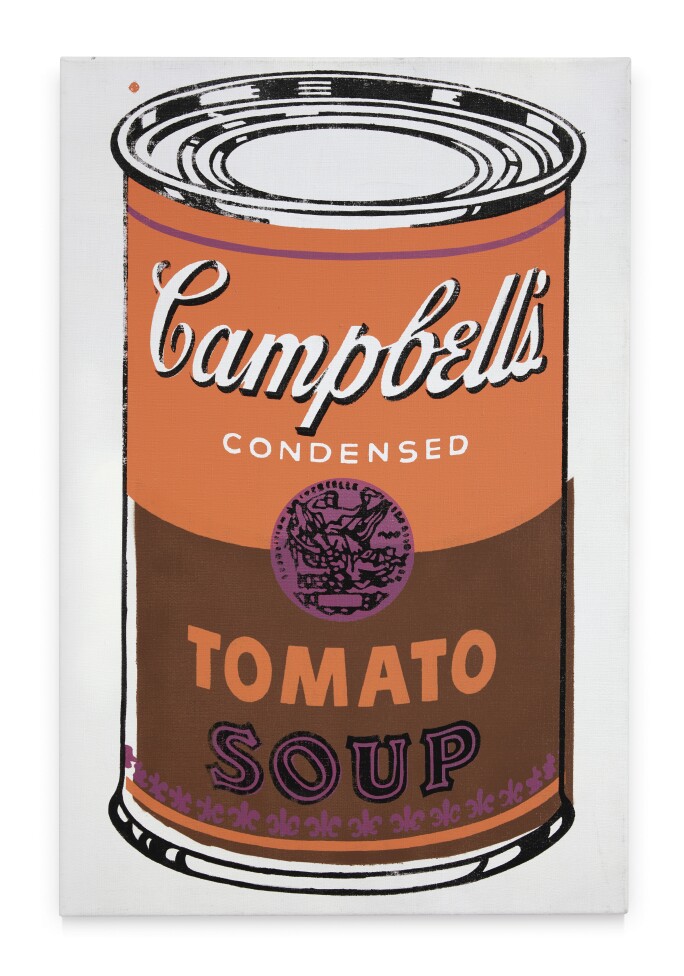
A rresting and timeless, Colored Campbell’s Soup Can, 1965 not only holds a wealth of art historical significance, but also represents the pinnacle of Andy Warhol’s conceptual vision that forever changed the direction of twentieth-century art. The present work is one of nineteen large canvases that premiered at Leo Castelli Gallery in New York in 1965, the very same year of its creation. Fittingly, the impressive lineage of Colored Campbell’s Soup Can is nothing short of art world lore.
The renowned Romanian-American art collector and dealer, Ileana Sonnabend, brokered what has come to be a key acquisition, as Sonnabend selected four notable examples herself, including the present work, which remained in her esteemed collection until her death in 2007. Following Sonnabend’s endorsement, several important private and museum collections acquired a painting from this series.
The signature motif that propelled Warhol’s ascent to stardom is considerably enhanced within Colored Campbell’s Soup Can; the brilliant palette of burnt orange, cool violet and deep amber crackles brightly against a crisply spray-painted white ground. The idea of painting the soup can initially came from a friend and designer in his circle, Murile Latow. At the end of 1961, Warhol turned to Latow for advice on the right subject matter; after writing a check for $50 to Latow she explained:
“You should paint something that everybody sees every day, that everybody recognizes...like a can of soup.”
E xecuted in a crisply registered palette of bright white flowers against a bold green background, Warhol’s Flowers embodies one of Pop Art’s most iconic bodies of work. In the half century since its creation, Warhol’s Flowers have infiltrated popular culture as a touchstone of classic American Pop. In keeping with Pop Art’s appropriation of popular, easily accessible, and everyday imagery, the source material for Flowers is a photograph of hibiscus blossoms from the June 1964 issue of Modern Photography magazine.

The bright subject matter of Flowers was a relief from the morbid 1962-63 Death and Disaster series, in which the artist depicted photographs of car crashes, electric chairs, and suicides. Yet, the motif of the hibiscus is laden with the tragedy that permeates Warhol’s oeuvre; hibiscuses signify beauty, but perhaps more importantly, also symbolize the fleeting nature of fame or personal glory, a meaning that would not have escaped Warhol.
It was Henry Geldzahler, then assistant curator at the Metropolitan Museum of Art, who suggested to Warhol that he devote an entire series solely to flowers as a way for the artist to engage directly in the art historical tradition of still-life painting. Warhol, however, stamped his own brand on this centuries-old tradition, rejecting traditional modes of representation and instead portraying this subject through the lens of contemporary Pop Art. Gerard Malanga notes:
“In a funny way, he was kind of repeating the history of art. It was like, now we’re doing my Flower period! Like Monet’s water lilies, van Gogh’s flowers, the genre.”
T he American Indian (Russell Means), 1976 offers a rare synthesis of Warhol’s devotion to popular culture and his adoption of political imagery. The subject of the series, Russell Means, a member of the Lakota culture, led the American Indian Movement during the highly-publicized, seventy-one day siege of the town of Wounded Knee – “the infamous site of an 1890 massacre of the Lakota by a U.S. Cavalry regiment” – as protest of the U.S. government’s alleged mistreatment of the Lakota people.

A focus of intense media scrutiny, the siege garnered significant attention in Hollywood, resulting in avid celebrity activism.
Though he positions his body three-quarters away from viewers, Means faces them straight-on: he turns his head to meet their gaze. Cropping the portrait to Means' bust – and therefore adopting the legacy of bust-portraiture, a form typically reserved for Western history’s great leaders – elevates Means’ status for Western viewers.
Each of these archetypes from Warhol’s oeuvre underscores the significant contributions the celebrated artist made to the history of art.




